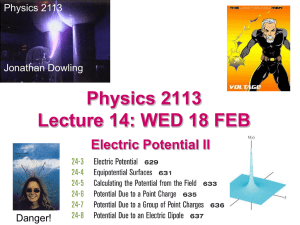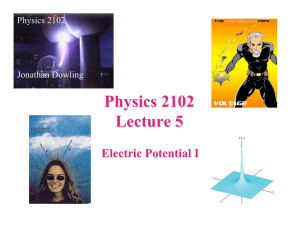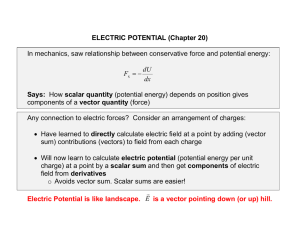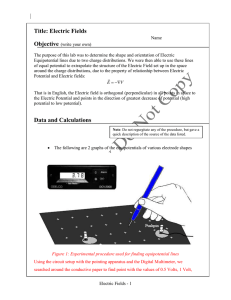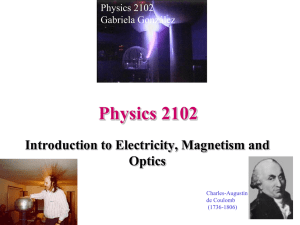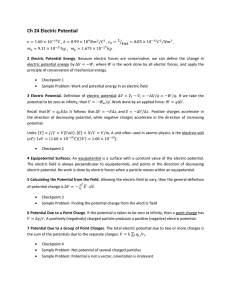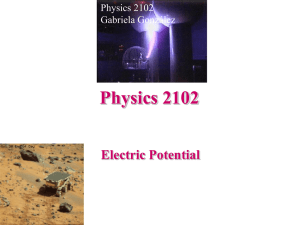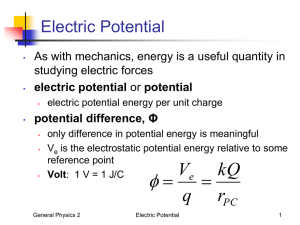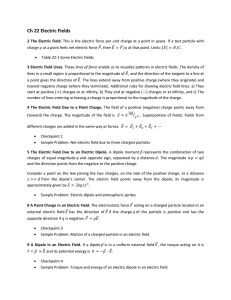pptx
advertisement
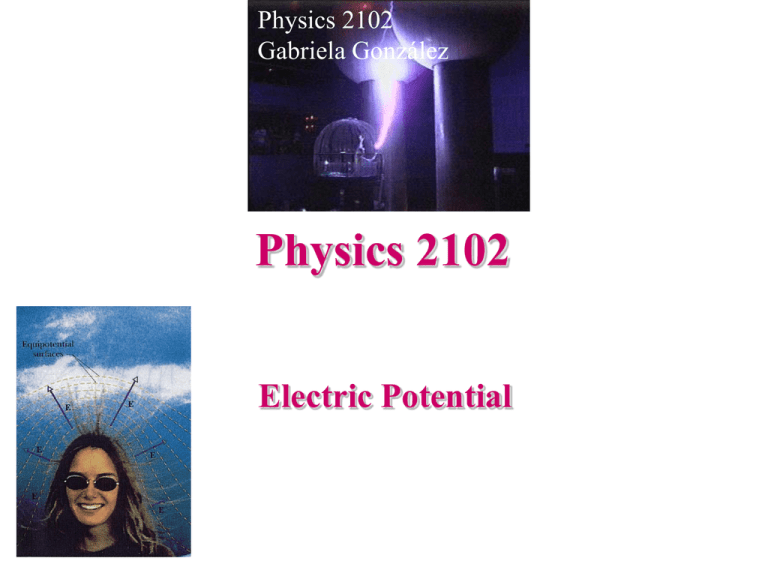
Physics 2102 Gabriela González Physics 2102 Electric Potential Electric potential energy, electric potential Electric potential energy of a system = = - work (against electrostatic forces) needed to needed to build the system U= - W Electric potential difference between two points = work per unit charge needed to move a charge between the two points: DV = Vf-Vi = -W/q Electric potential energy, electric potential Units : [U] = [W]=Joules; [V]=[W/q] = Joules/C= Nm/C= Volts [E]= N/C = Vm 1eV = work needed to move an electron through a potential difference of 1V: W=qDV = e x 1V = 1.60 10-19 C x 1J/C = 1.60 10-19 J Electric field lines and equipotential surfaces Given a charged system, we can: • calculate the electric field everywhere in space • calculate the potential difference between every point and a point where V=0 • draw electric field lines • draw equipotential surfaces Equipotential Surfaces & Electric Field • In a uniform electric field E, equipotentials are PLANES. • Electric field points towards lower potential. • In a gravitational field, a free mass moves from high to low potential. In an electric field, which of the following is true? (a) Positive charge moves to lower V, negative charge moves to higher V (b) Positive charge moves to higher V, negative charge moves to lower V (c) All charge moves to lower V. -Q +Q +V 0 -V Note: all charges freely move to regions of lower potential ENERGY! Don’t confuse potential with potential energy! Electric Potential of a Point Charge Potential = V = “Work you have to do to bring +1 C from infinity to distance r away from a point charge Q” V -W / q - F d s / q r Note: if Q were a negative charge, V would be negative r E ds r r E ds r kQ r 2 r dr Q Q - - k k R r Electric Potential of Many Point Charges • Electric potential is a SCALAR • Just calculate the potential due to each individual point charge, and add together! (Make sure you get the SIGNS correct!) V i k qi ri q4 r3 r4 q5 r5 Pr2 q2 r1 q1 q3 Electric Potential of a Dipole (on axis) What is V at a point at an axial distance r away from the midpoint of a dipole (on side of positive charge)? Q V 4 0 ( r - a Q - 4 0 ( r ) 2 a a (r ) - (r - ) Q 2 2 a a 4 0 ( r - )( r ) 2 2 2 a Qa 4 0 ( r 2 a 2 4 ) ) a -Q +Q r Far away, when r >> a: p V 2 4 0 r Electric Potential on Perpendicular Bisector of Dipole You bring a charge of -3C from infinity to a point P on the perpendicular bisector of a dipole as shown. Is the work that you do: a)Positive? b)Negative? c)Zero? a -Q +Q P -3C Electric Potential of Many Point Charges What is the electric potential at the center of each circle? • Potential is a SCALAR • All charges are equidistant from each center, hence contribution from each charge has same magnitude: V • +Q has positive contribution • -Q has negative contribution A: -2V+3V = +V B: -5V+2V = -3V C: -2V+2V = 0 Note that the electric field at the center is a vector, and is NOT zero for C! -Q A B C +Q Continuous Charge Distributions • Divide the charge distribution into differential elements • Write down an expression for potential from a typical element -- treat as point charge • Integrate! • Simple example: circular rod of radius R, total charge Q; find V at center. R dq V 1 4 0 dq 4 0 R Q dq R 4 0 R Potential of Continuous Charge Distribution: Example • • • • Uniformly charged rod q/L Total charge q Length L kdq What is V at position P V shown? r x P dq dx L k dx (L a - x) 0 k - ln( L a - x ) L 0 dx L a L a V k ln a Summary: • Electric potential: work needed to bring +1C from infinity; units = V • Electric potential uniquely defined for every point in space -- independent of path! • Electric potential is a scalar -- add contributions from individual point charges • We calculated the electric potential produced: – by a single charge: V=kq/r, – by several charges using superposition, and – by a continuous distribution using integrals.
